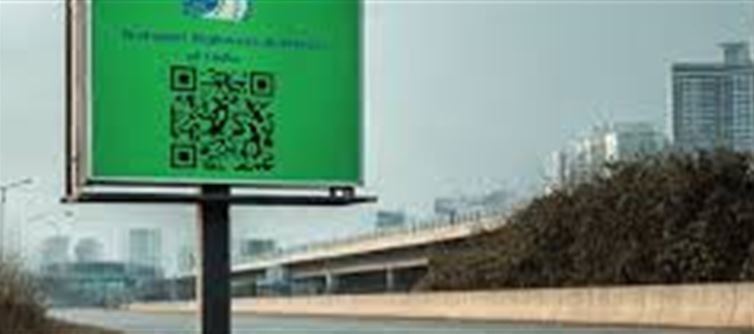
In a major step towards modernizing and making indian highways more traveler-friendly, the National Highways Authority of india (NHAI) has launched a smart initiative that’s set to revolutionize highway travel. QR code-enabled signboards are now being placed along major highways to offer real-time information to commuters, enhancing their journey with up-to-date details about road conditions, traffic, weather, and more. Here’s everything you need to know about this game-changing development.
1. What Are QR Code Signboards?
The new initiative involves placing QR code-enabled signboards at key locations along national highways. These signboards feature Quick Response (QR) codes that travelers can scan with their smartphones to get instant access to a wealth of information. Once scanned, users are directed to a dedicated webpage or app providing real-time updates on the highway's condition, ongoing roadworks, toll information, nearby amenities, and much more.
· Quick and Easy Access: Simply scan the code with your phone’s camera and get immediate details.
· Comprehensive Information: Includes traffic updates, accidents, diversion routes, and even weather forecasts along the highway.
2. Real-Time Updates: Information That Makes Your journey Smarter
Gone are the days of relying on paper maps, asking for directions, or hoping for the best when stuck in traffic. The QR code system gives drivers instant access to real-time information. Whether it’s a roadblock up ahead, a heavy traffic jam, or a detour due to construction, you’ll always know what to expect. Some of the key updates include:
· Traffic and Congestion Alerts: Get notified about traffic jams or accidents in your route, helping you plan accordingly.
· Weather Updates: Stay informed about weather conditions that may affect your travel, like heavy rains or fog.
· Toll Information: Find out about toll charges, whether you can use an electronic toll collection system, and the nearest toll booths.
3. Enhancing Safety and Reducing Travel Stress
The main objective of this initiative is to enhance road safety and reduce stress for travelers. By providing vital information in real-time, the QR code signboards help drivers make informed decisions on the go. For instance, if a traveler knows there’s an accident ahead, they can either delay their trip or take an alternative route to avoid delays and accidents.
In addition, the system can also help reduce instances of wrong turns or taking unfamiliar detours, which can be particularly frustrating for long-distance travelers or those new to the area.
· Safer Travel: Real-time alerts help prevent accidents and reduce driver anxiety.
· Informed Decision-Making: Travelers can make better choices, whether it’s avoiding heavy traffic or finding a nearby rest stop.
4. Connecting the Dots: The Role of technology in Highway Management
This initiative is part of NHAI’s larger goal to modernize India’s highway infrastructure and provide a more seamless experience for travelers. QR codes are just the beginning of what could soon become a fully integrated highway management system, where AI, data analytics, and the Internet of Things (IoT) work in harmony to optimize the entire travel experience.
· Data-Driven Insights: The data collected through QR code scans can be used to analyze traffic patterns, identify problem areas, and improve road maintenance schedules.
· Digital Integration: This is a step toward making highways smarter by connecting different data points—traffic flow, weather, accidents, and toll collection—into one unified system.
5. How Can Travelers Use QR Code Signboards?
Using the new QR code signboards is easy and requires no technical knowledge. Here’s how you can use them:
1. Scan the QR Code: Simply use your smartphone camera or any QR scanning app to scan the code on the signboard.
2. Access Information: Instantly access a webpage or mobile app with all the relevant details about your journey.
3. Follow Updates: Keep track of the latest updates during your journey to make the best decisions while on the road.
· No App Needed: The service doesn’t require downloading a specific app; it works directly through your phone’s camera.
6. The Future of Highway Travel: More Smart Features to Come
While QR code-enabled signboards are a great start, this is just the tip of the iceberg. As technology continues to evolve, we can expect more smart features to be added to our highways. Some potential additions include:
· AI-Powered Traffic Predictions: Using historical data and real-time inputs, AI could predict traffic congestion and recommend alternate routes before you even begin your journey.
· Smart Parking & Rest Stops: Real-time updates on available parking spaces or restrooms at highway stops to improve comfort and convenience.
· Automatic Vehicle Recognition: Toll booths that automatically recognize vehicles, making the entire tolling process smoother and quicker.
7. Conclusion: NHAI’s Vision of Smarter Highways
The introduction of QR code signboards is a significant step towards transforming India’s highways into smart, connected corridors. By empowering travelers with real-time information, NHAI is not only improving the safety and efficiency of highway travel but also creating a more pleasant experience for everyone on the road. As the initiative expands, we can look forward to a future where highways are not just routes to our destinations but also intelligent systems that guide us through safer, smoother, and more efficient journeys.
Disclaimer:
The views and opinions expressed in this article are those of the author and do not necessarily reflect the official policy or position of any agency, organization, employer, or company. All information provided is for general informational purposes only. While every effort has been made to ensure accuracy, we make no representations or warranties of any kind, express or implied, about the completeness, reliability, or suitability of the information contained herein. Readers are advised to verify facts and seek professional advice where necessary. Any reliance placed on such information is strictly at the reader’s own risk..jpg)




 click and follow Indiaherald WhatsApp channel
click and follow Indiaherald WhatsApp channel